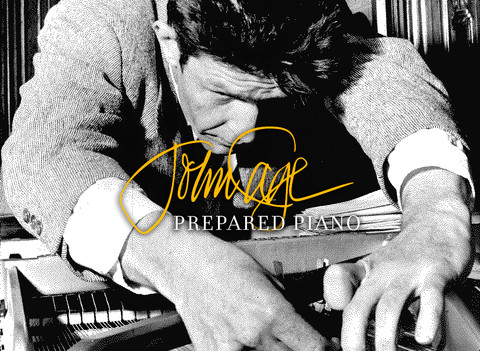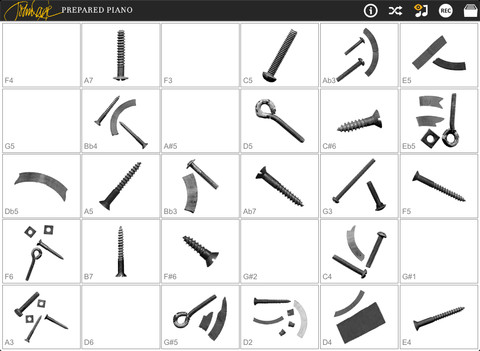The John Cage Trust has released an app for iOS and Android devices. It’s a demonstration of Cage’s prepared piano and ties into the recent recording of the Sonatas and interludes released by the Trust. The Trust owns materials—screws, bolts, pieces of rubber and felt—actually used by Cage himself to prepare the piano for his own performances of Sonatas and interludes. What they present in the app are sampled notes from a piano prepared using these materials, so that you can play with the sounds yourself.
The main screen of the app shows a grid of cells, each with a picture of some of the preparation hardware. When you tap on a cell, you hear the sound of the piano note that is prepared using those particular materials. They’ve even included some unprepared tones as well (the blank cells), just like in Sonatas in interludes itself. You can make up your own tunes and record them, share them with friends, use them as ring tones, etc. It’s all very elegantly done. The only things I wish it had are a piano keyboard interface and options for pedals (both una corda and sostenuto).
This week I spoke to Julia Wolfe’s string quartet class at NYU about the Cage string quartet, and the app was the perfect audiovisual aid. When I talk about the quartet, I like to say that it’s a piece for prepared piano that’s been transcribed for string quartet. To explain the workings of a prepared piano, I just whipped out my iPad and showed them the app, how different materials make for different kinds of sounds, etc. Very handy, since the room didn’t have a grand piano in it!
But the app helps explain the quartet in other, subtler ways, too. The string quartet is when Cage really consciously understood that his way of composing was collecting materials and then arranging them into his time structures. Composing for prepared piano (or percussion, for that matter) forces that way of thinking. The layout of the app itself reveals this: a screen full of material that you have to put into order. It’s a handy visualization of the material basis for composition on one hand-held grid (well, in the case of the iPad, maybe two-hand-held).
Cage composed the string quartet by doing the same thing: create a collection of sonorities scored for strings, then arrange them in time. The results pleased him and suggested a path to be followed further. In his next work, the Concerto for prepared piano and chamber orchestra, he defined his materials in advance as well, but this time arranged them in rectangular charts. And once again, I turned to the app: the materials are already in chart! As the similarities between the app and Cage’s compositional materials show, a grid arrangement is a natural way of visualizing a collection of musical materials like this.
One can easily imagine the 38-year-old John Cage of 1950 playing with the app, getting ideas about how to compose. One could make geometric moves on the app, just as Cage did for the concerto, and create tunes that way. Perhaps I don’t really need that keyboard interface …


